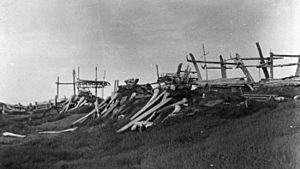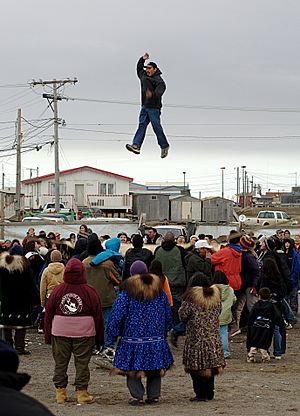Inupiat people facts for kids

|
|
| Total population | |
|---|---|
| 44,331 (2015) | |
| Regions with significant populations | |
| North and northwest Alaska (United States) | |
| Languages | |
| North Alaskan Inupiatun, Northwest Alaskan Inupiatun, English |
|
| Religion | |
| Animism | |
| Related ethnic groups | |
| Inuit, Yupik |
The Iñupiat (say: Ee-nyoo-pee-at) are a group of native Alaskan people. Their traditional lands stretch from Norton Sound on the Bering Sea all the way to the border with Canada. Today, Iñupiat communities live in different areas of Alaska. These include the North Slope Borough, the Northwest Arctic Borough, and the Bering Straits Regional Corporation area.
Contents
What the Name "Iñupiat" Means
The word Iñupiat is the plural form, meaning "the people." It also refers to their language. The singular form is Iñupiaq (say: Ee-nyoo-pee-ak), which means "a person." Sometimes, this word also refers to the language.
The word comes from two parts: iñuk meaning "person" and -piaq meaning "real." So, Iñupiat means "real people."
Iñupiat Communities and Groups
Different Iñupiat Groups
The Iñupiat people are made up of several communities. These include:
- Bering Strait Inupiat
- Nunamiut
- Kotzebue Sound Inupiat
- North Alaska Coast Inupiat (also called Taġiuġmiut, meaning "people of the sea")
Regional Corporations and Resources

To help manage their natural resources fairly, Iñupiat people belong to several Alaskan Native Regional Corporations. These corporations help protect and manage the land and resources for the Iñupiat people. The main ones are:
- Arctic Slope Regional Corporation
- Bering Straits Native Corporation
- NANA Regional Corporation
Languages of the Iñupiat
Today, Iñupiat people mainly speak two native languages: North Alaskan Inupiat and Northwest Alaskan Inupiat. In the past, there were many more dialects. Most Iñupiat also speak English. This is partly because in the past, children in Native American boarding schools were often not allowed to speak their own languages.
Some Iñupiat people created their own picture-based writing systems in the early 1900s. This is known as Alaskan Picture Writing.
The University of Alaska Fairbanks offers online courses to learn the Inupiaq language. These courses are open to everyone.
History of the Iñupiat
The Iñupiaq people, like other Inuit groups, came from the Thule culture. Around 1000 B.C., they moved from islands in the Bering Sea to what is now Alaska.
Many Iñupiaq groups have names that end in "miut." This means "a people of" a certain place. For example, the Nunamiut are Iñupiaq people who traditionally hunted caribou inland. Between 1890 and 1910, many Nunamiut moved to the coast or other parts of Alaska due to hard times and illness. Some Nunamiut returned to the mountains in the 1930s.
By 1950, most Nunamiut groups gathered in Anaktuvuk Pass, a village in north-central Alaska. Some Nunamiut continued to live a nomadic life, moving from place to place, until the 1950s.
The famous Iditarod Trail in Alaska was originally made from old trails used by Native American groups, including the Iñupiaq.
How the Iñupiat Live
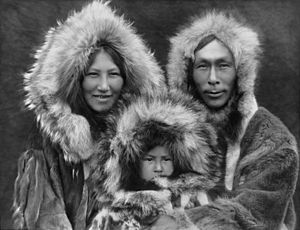
Iñupiat people are hunter-gatherers. This means they get their food by hunting animals and gathering plants. They still rely a lot on hunting and fishing for their food. Depending on where they live, they hunt walrus, seals, whales, polar bears, caribou, and various types of fish.
Both the inland Iñupiat (Nunamiut) and coastal Iñupiat (Taġiumiut) depend heavily on fish. They also eat ducks, geese, rabbits, berries, roots, and shoots when these foods are available.
Inland Iñupiat also hunt dall sheep, grizzly bears, and moose. Coastal Iñupiat hunt walrus, seals, beluga whales, and bowhead whales. They also carefully hunt polar bears.
When a whale is caught, it benefits everyone in an Iñupiat community. The meat and blubber are shared according to old traditions. Even family members who live far away are entitled to a share. Maktak, which is the skin and blubber of Bowhead and other whales, is full of vitamins A and C. Eating raw meats helps them get these important vitamins, especially since fresh fruits and vegetables are not always easy to find.
Since the 1970s, oil has become an important source of money for the Iñupiat. The Alaska Pipeline carries oil from Prudhoe Bay to the port of Valdez. However, oil drilling in Alaska's north can sometimes conflict with the traditional way of whaling.
The Iñupiat also eat Ribes triste berries raw or cooked. They mix them with other berries to make traditional desserts. They also boil these berries with rosehips and highbush cranberries to make a syrup.
Iñupiat Culture
Traditionally, some Iñupiat lived in settled communities, while others moved around. Some villages have been lived in for over 10,000 years, like the Mary's Igloo fish camp.
The Nalukataq is a special spring whaling festival for the Iñupiat. It celebrates a successful whale hunt.
There is a college focused on Iñupiat culture called Iḷisaġvik College. It is located in Barrow.
Current Issues for the Iñupiat
Iñupiat people are worried that climate change is threatening their traditional way of life. The Arctic is getting warmer, which affects them in many ways. For example:
- Thinning sea ice makes it harder and more dangerous to hunt bowhead whales, seals, and walrus.
- Warmer winters make travel across the land more dangerous and less predictable.
- When sea ice forms later in the year, it causes more flooding and erosion along the coast. This directly threatens many coastal villages.
The Inuit Circumpolar Council, a group that represents Arctic indigenous peoples, believes that climate change is a threat to their human rights.
As of 2000, there were more than 19,000 Iñupiat people in the United States. Most of them live in Alaska.
Iñupiat Territories
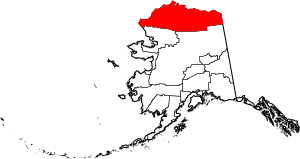
North Slope Borough : Anaktuvuk Pass, Atqasuk, Barrow, Kaktovik, Nuiqsut, Point Hope, Point Lay, Wainwright
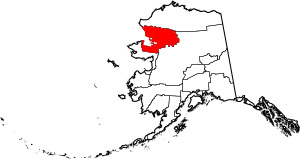
Northwest Arctic Borough : Ambler, Buckland, Deering, Kiana, Kivalina, Kobuk, Kotzebue, Noatak, Noorvik, Selawik, Shungnak
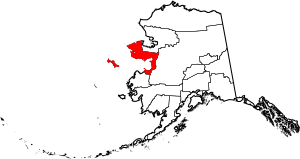
Nome Census Area : Brevig Mission, Diomede, Golovin, Koyuk, Nome, Shaktoolik, Shishmaref, Stebbins, Teller, Wales, White Mountain, Unalakleet
Notable Iñupiat People
- Edna Ahgeak MacLean (born 1944), an Inupiaq expert in language, culture, and education.
- Eddie Ahyakak (born 1977), an Iñupiaq marathon runner and skilled mountain climber.
- Irene Bedard (born 1967), an actress.
- Ticasuk Brown (1904–1982), an educator, poet, and writer.
- Charles "Etok" Edwardsen, Jr. (1943-2015), an activist for Alaska Native land rights.
- Ronald Senungetuk (born 1933), a sculptor, silversmith, and educator.
Images for kids
-
Students from Iḷisaġvik College with Senator Lisa Murkowski.


